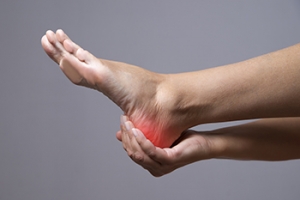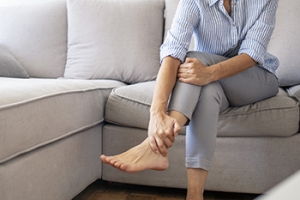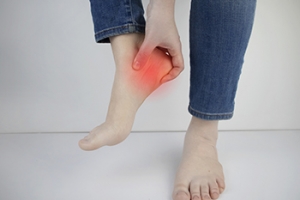Super User
Gout
Gout is a type of arthritis that can affect the foot. Gout is caused by a buildup of uric acid in the bloodstream. When uric acid levels become excessive, this substance can create crystals in the joints, causing severe pain, intense swelling, redness, and warmth. Typically this occurs in the big toe joint.
You may be at an increased risk of developing gout if you are a middle-aged man or postmenopausal woman, have family members who have had gout, drink alcohol, take certain medications, or have a medical condition like high blood pressure, kidney disease, thyroid disease, diabetes, or sleep apnea. Gout may also be more likely to develop if you consume a diet high in sugars or purines, a substance that turns into uric acid when it breaks down. Foods high in purines include organ meats, red meat, oily fish, certain vegetables, beans, and mushrooms.
Gout that is left untreated can become chronic and lead to arthritis. Gout can be treated by a chiropodist. Treatment options may include taking medications to relieve pain and prevent future gout attacks, modifying your diet, and reducing alcohol intake. For more information about gout, please consult with a chiropodist.
Common Causes of Heel Pain
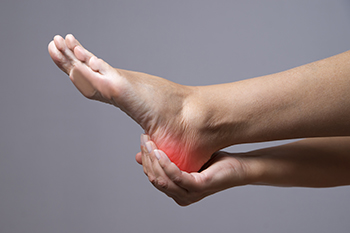
Heel pain is generally considered an overuse injury, most commonly caused by plantar fasciitis, Achilles tendonitis, or arthritis. Other causes include heel bursitis, stress fractures, and tarsal tunnel syndrome. Plantar fasciitis, the most common form of heel pain, is frequently caused by wearing shoes that lack support or proper cushioning while running or jumping on hard surfaces. Other causes include flat feet, high arches, aging, and being overweight. These conditions can cause the plantar fascia, a band of tissue that connects the toes to the heel, to get overstretched and become inflamed. Achilles tendonitis is the inflammation of the Achilles tendon, which connects the leg bones to the heel. Bursitis is an inflammation of the bursa, sacs of fluid behind the heel. Stress fractures can be caused by heavy pounding on the heel, during certain sports activities or running. Tarsal tunnel syndrome is caused by a pinched nerve. Aging can cause the fat pads in the heel to thin out, resulting in less natural cushioning. Obesity places extra pressure on the heel, even during normal daily activities. Please consult a chiropodist for help with any heel pain you may be experiencing.
Heel pain is a common problem that can be caused by a variety of injuries, medical conditions, and other factors. If you suffer from heel pain, please consult with one of the chiropodists from The Footcare Centre. Our chiropodists can help you maintain the health of your lower limbs and your mobility.
When it comes to heel pain, the exact location and type of pain are important to note. Some of the conditions that may cause heel pain include:
Plantar fasciitis - An inflammation of the ligament that runs along the bottom of the foot; it causes a stabbing pain under the heel that is at its worst when taking your first few steps after a long rest and while standing on your tiptoes or climbing stairs
Achilles tendonitis - An inflammation of the tendon in the back of the calf; it causes pain in the back of the heel that is at its worst after resting, as well as ankle and calf stiffness, swelling, and tenderness
Bone spurs - Bony lumps on the back of the heel bones that cause sharp pain upon first standing up; the pain becomes dull and achy over time
Heel fractures - A break or crack in the heel bone that causes pain, swelling, and difficulty walking
Retrocalcaneal bursitis - Swelling of the small, fluid-filled sac at the back of the heel bone; it causes pain, swelling, redness, and warmth in the back of the heel
Tarsal tunnel syndrome - Compression of the posterior tibial nerve which causes a pins and needles sensation in the heel, foot, and calf
Your chiropodist will be able to diagnose the underlying cause of your pain and prescribe the right treatments for you. If you have any questions, please feel free to contact our office located in . We offer the newest diagnostic and treatment technologies for all your foot care needs.
Heel Pain
Heel pain can range in severity from mild and annoying to severe and debilitating. Usually caused by an injury, heel pain can become chronic if it's left untreated. There are many different types of injuries that can bring about heel pain. When describing your pain, it is important to note the location and type of pain, as well as when the pain started and what activities make it better or worse.
Perhaps the most common cause of heel pain is plantar fasciitis, a condition in which the plantar fascia, a ligament that runs along the bottom of the foot, becomes inflamed due to repetitive overuse or trauma. This condition causes stabbing pain in the bottom of the heel. The pain is usually at its worst when you take your first few steps after a period of rest, like when you first get up in the morning. Plantar fasciitis is also sometimes accompanied by bone spurs, calcium deposits on the heel bone that can cause sharp pain that gradually evolves into a dull ache. Other possible causes of heel pain include Achilles tendonitis, heel fractures, bursitis, tarsal tunnel syndrome, and Sever’s disease.
Although treatment for heel pain depends on the underlying cause, most treatments involve resting, icing, and elevating the affected foot. Your chiropodist will also typically suggest that you wear more comfortable, supportive shoes or orthotics to help your heel heal. Over-the-counter pain medications are usually sufficient to manage heel pain. For more information about heel pain, please consult with a chiropodist.
How Rheumatoid Arthritis Can Affect the Feet
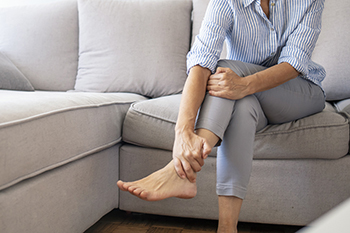
Rheumatoid arthritis (RA) is a painful and debilitating autoimmune disease that grows worse with age. It is caused by an inflammation of the capsule around a joint, particularly in the hands and feet. Women are more likely to have RA than men. Other risk factors include being between 40 and 50 years old, being a smoker, and genetic factors. Among the most common symptoms of RA are painful, swollen, and warm joints of the feet. These joints are often stiff upon awakening or after long periods of activity. As the disease progresses, the joints may erode, leading to joint damage and deformity. While there is no definitive cure for rheumatoid arthritis, it can be managed through medication, including non-steroidal anti-inflammatories and certain immunosuppressants. It has been shown that eating particular foods can help to reduce the effects of rheumatoid arthritis. Fish and other seafood that is packed with omega-3 fats are recommended. Avoiding foods that are high in saturated fats and sugar is also thought to be helpful. For more information on treatment for rheumatoid arthritis in the feet, please consult a chiropodist.
Rheumatoid arthritis (RA) is an autoimmune disorder in which the body’s immune system attacks its own otherwise healthy joint lining or synovium. While RA can affect any joint in the body, it often affects the small joints of the feet and the ankle joint. If you’re dealing with RA in your lower limbs, please consult with one of the chiropodists from The Footcare Centre. Our chiropodists can help you maintain the health of your lower limbs and your mobility.
Symptoms of RA primarily affect the joints of the feet and may include:
Pain
Swelling
Stiffness
Redness
Warmth
Difficulty walking
Gait changes
Bunions
Hammertoes
Treatment
While there is no cure for RA, your chiropodist can help you manage the health of your feet and maintain your mobility while living with this condition. Possible treatments include wearing orthotics, doing foot and ankle exercises, resting the feet, taking anti-inflammatory medications, getting steroid injections, and wearing braces for foot and ankle pain. In advanced cases of RA, joint replacement surgery may be helpful for mobility. Bunions, hammertoes, and other deformities can be corrected with surgery as well.
If you have RA, please feel free to contact our office located in . We offer the newest diagnostic and treatment technologies for all your foot care needs.
Rheumatoid Arthritis
Rheumatoid arthritis (RA) is an autoimmune disorder in which the body’s immune system attacks its own otherwise healthy joint lining. This condition can affect any of the 33 joints of the feet, as well as the ankle joints. RA symptoms include joint pain, stiffness, swelling, and warmth. It may become difficult to stand, walk, or exercise due to joint pain. RA can also affect the biomechanics of the feet. When the structure of the foot changes, this can affect one’s gait or walking pattern. Foot deformities, such as bunions and hammertoes, also become more likely. RA’s negative effects on mobility could impact one’s overall quality of life.
Although there is no cure for RA, your chiropodist can help you manage symptoms and maintain the health of your feet and your mobility. They may recommend conservative treatments such as resting and icing the feet and taking non-steroidal anti-inflammatory medications to manage pain. Orthotic inserts and braces can help reduce pain and give the feet structure and support. In more severe cases, corticosteroid injections can be used to relieve pain as well.
Surgical treatments for joint pain are another possible option for those with RA, particularly if the conservative treatment methods described above prove ineffective. Joint fusion surgery or joint replacement surgery may help. Deformities like bunions and hammertoes can be surgically corrected as well.
To learn more about living with RA, please consult with a chiropodist near you.
Foods That May Help to Prevent Plantar Fasciitis

Research has shown that eating specific types of foods may have an impact on foot pain. Plantar fasciitis is a foot condition that can cause extreme discomfort, and walking may become difficult. It is defined as an inflammation of the plantar fascia, which is located on the sole of the foot. Its job is to connect the heel to the toes, and plays a crucial role in walking and running. There are studies that have been performed which shows that certain types of foods can cause inflammation, and this may affect the plantar fascia. When more anti-inflammatory foods are consumed, the amount of inflammation may be reduced, and this may deter plantar fasciitis from developing. Eating leafy, green vegetables is known to possibly prevent chronic diseases. These types of foods have elevated levels of vitamins K and D, which may help to reduce inflammation. Foods that are suggested to be avoided can consist of sugar, processed foods, and saturated fats. If you would like more information about what types of foods to eat that may help or prevent plantar fasciitis, please consult with a chiropodist who can answer any questions you may have.
Plantar fasciitis can be painful and interfere with your daily activities. If you are experiencing foot or heel pain and believe you may be afflicted with plantar fasciitis, please consult with one of the chiropodists from The Footcare Centre. Our chiropodists will assess your condition and provide you with quality foot and ankle treatment.
What Is Plantar Fasciitis?
Plantar fasciitis refers to the inflammation of the plantar fascia, a ligament that runs along the bottom of the foot and connects the heel bone to the toes. Repetitive activities, such as running or jumping, can injure the plantar fascia over time. Plantar fasciitis can also be caused by flat feet, high arches, pregnancy, and activities that put excessive pressure on your feet, like standing all day for work. When the plantar fascia becomes inflamed, it causes pain and discomfort.
Symptoms
Typical symptoms of plantar fasciitis include:
Stabbing pain near the heel
Pain that is worst in the morning or after a period of rest
Pain that increases after exercising
Swelling
Tightness in the Achilles tendon
Diagnosis
Plantar fasciitis is typically diagnosed via medical history and physical examination.
Treatment
Treatments for plantar fasciitis include resting and icing the affected foot, stretching the foot, taking medications to reduce inflammation, and wearing orthotics. In severe cases where pain does not improve with conservative treatments, injections or surgery may be recommended.
If you have any questions, please feel free to contact our office located in . We offer the newest diagnostic and treatment technologies for all your foot care needs.
Plantar Fasciitis
The plantar fascia is a thick ligament that runs along the bottom of your foot and connects the heel bone to the toes. When the plantar fascia becomes inflamed, typically due to overuse, it can cause a condition called plantar fasciitis. Plantar fasciitis is characterized by a sharp, stabbing heel pain, arch pain, and pain that is at its worst when taking your first steps after a long resting period, such as when you first wake up in the morning. You may also notice swelling on the bottom of the heel.
Plantar fasciitis is one of the most common foot ailments, and one of the most common causes of heel pain. Besides overuse from activities such as running or jumping, wearing shoes that do not have adequate cushioning and support, standing for prolonged periods of time, being obese, or having flat feet can all increase your risk of developing plantar fasciitis.
Fortunately, there are many treatments for this condition. Your chiropodist may recommend stretching exercises, activity and footwear changes, and icing the affected foot to help relieve pain. If pain persists after several weeks, your chiropodist may prescribe custom orthotics, pad, tape, strap, or immobilize the affected foot, or inject a corticosteroid into the area to reduce pain.
For more information about plantar fasciitis, please consult with a chiropodist.
Ways Pregnancy Can Affect Your Feet

It is quite common for women to experience swelling and other changes in the feet during pregnancy. In most cases, these symptoms go away after delivery. Weight gain and a buildup of fluids in the feet can cause them to swell. Extra fluid in the body tends to collect in the ankles and feet. Swelling, or edema, may increase as the pregnancy advances. Edema may cause a woman’s foot size to change during pregnancy. Redness and itching may occur in the feet, as a result of hormonal changes. Most experts recommend that pregnant women keep their feet and legs elevated as often as possible. It is also suggested that they avoid standing for long periods. Wearing shoes with ample support and cushioning can help to maintain a level of comfort. If swelling or other foot ailments become more serious, it is a good idea to check in with a chiropodist for an examination.
Pregnancy can affect your feet in many ways, often causing pain or discomfort, as well as reduced mobility. If you are pregnant and experience foot pain, please consult with one of the chiropodists from The Footcare Centre. Our chiropodists will assess your condition and provide you with quality foot and ankle treatment.
During pregnancy, your belly isn’t the only part of your body swelling. The whole body may experience swelling, especially in the feet and ankles. Since they carry the weight of both your body and the baby’s, caring for your feet during pregnancy is very important.
Common Foot Conditions During Pregnancy
Various foot conditions can develop during the course of a pregnancy, including:
Swelling of the feet and ankles
Fallen arches, leading to acquired flat feet
Plantar fasciitis
Aching, sore feet
Changes in the toenails
Caring for the Feet During Pregnancy
Some things that you can do to help maintain the health of your feet during pregnancy include:
Wearing comfortable shoes
Resting and elevating your feet
Icing sore areas, such as the arch
Keeping your toenails trimmed
Soaking and massaging the feet
If you have any questions, please feel free to contact our office located in . We offer the newest diagnostic and treatment technologies for all your foot care needs.
Pregnancy and Foot Health
Many changes can happen in every part of your body during pregnancy — and the feet are no exception. Common foot conditions that pregnant women face include swollen feet, fallen arches, and plantar fasciitis.
An increase in the volume of blood and fluids in your body, coupled with an increase in overall fluid retention due to hormones, can lead to swelling in the feet. This is especially common during the third trimester. You may be able to reduce swelling by drinking plenty of water, reducing caffeine intake, resting your feet frequently, and sitting with your legs uncrossed to promote circulation.
During pregnancy, your hormones can cause changes in the structure of your feet. An increase in hormones that relax your ligaments could affect the ligaments in the arches of your feet, causing them to become flat. This condition is known as fallen arches, or acquired flat feet. As the foot flattens, your shoe size may increase and you may need footwear that offers more arch support.
The weight that you gain during pregnancy is carried by your feet. This can put them under extra strain and lead to aches, soreness, or a condition known as plantar fasciitis. Plantar fasciitis is caused by an inflammation of the ligament that connects the heel bone to the toes and can lead to heel and arch pain.
If you are pregnant and are experiencing pain or discomfort in your feet, it is recommended that you consult with a chiropodist.
